[Editor’s Note: Story Telling is a powerful tool that allows us to envision how innovative and potentially disruptive technologies could be employed and operationalized in the Future Operational Environment. In today’s guest blog post, proclaimed Mad Scientist Mr. August Cole and Mr. Amir Husain use story telling to effectively:
- Describe what the future might look like if our adversaries out-innovate us using Artificial Intelligence and cheap robotics;
- Address how the U.S. might miss a strategic breakthrough due to backward-looking analytical mindsets; and
- Imagine an unconventional Allied response in Europe to an emboldened near-peer conflict.
Enjoy reading how the NATO Alliance could react to Omega — “a Russian autonomous joint force in a … ready-to-deploy box… [with an] area-denial bubble projected by their new S-600s extend[ing] all the way to the exo-sphere, … cover[ing] the entirety of the ground, sea and cyber domains” — on the cusp of a fictional not-so-distant future near-peer conflict!]
Omega
22 KILOMETERS NORTH OF KYIV / UKRAINE
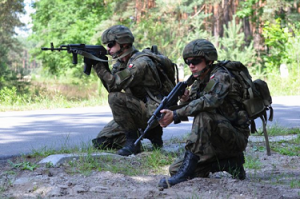 “Incoming!” shouted Piotr Nowak, a master sergeant in Poland’s Jednostka Wojskowa Komandosów special operations unit. Dropping to the ground, he clawed aside a veil of brittle green moss to wedge himself into a gap beneath a downed tree. He hoped the five other members of his military advisory team, crouched around the fist-shaped rock formation behind him, heard his shouts. To further reinforce Ukraine’s armed forces against increasingly brazen Russian military support for separatists in the eastern part of the country, Poland’s government had been quietly supplying military trainers. A pro-Russian military coup in Belarus two weeks earlier only served to raise tensions in the region – and the stakes for the JWK on the ground.
“Incoming!” shouted Piotr Nowak, a master sergeant in Poland’s Jednostka Wojskowa Komandosów special operations unit. Dropping to the ground, he clawed aside a veil of brittle green moss to wedge himself into a gap beneath a downed tree. He hoped the five other members of his military advisory team, crouched around the fist-shaped rock formation behind him, heard his shouts. To further reinforce Ukraine’s armed forces against increasingly brazen Russian military support for separatists in the eastern part of the country, Poland’s government had been quietly supplying military trainers. A pro-Russian military coup in Belarus two weeks earlier only served to raise tensions in the region – and the stakes for the JWK on the ground.
An instant later incoming Russian Grad rocket artillery announced itself with a shrill shriek. Then a rapid succession of sharp explosive pops as the dozen rockets burst overhead. Nowak quickly realized these weren’t ordinary fires.
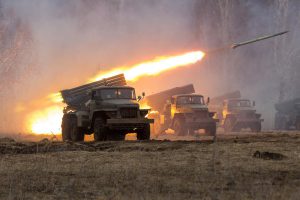
There was no spray of airburst shrapnel or the lung-busting concussion of a thermobaric munition. Instead, it sounded like summer fireworks – the explosive separation of the 122mm rocket artillery shell’s casing. Once split open, each weapon’s payload deployed an air brake to slow its approach.
During that momentary silence, Nowak edged out slightly from under the log to look up at the sky. He saw the drifting circular payload extend four arms and then, suddenly, it came to life as it sprang free of its parachute harness. With a whine from its electric motors, the quadcopter darted out of sight.
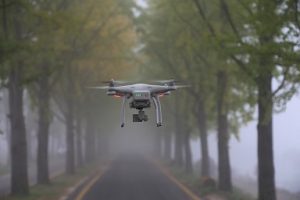
That sound built and built over the next minute as eleven more of these Russian autonomous drones darted menacingly in a loose formation through the forest above the Polish special operations commandos. Nowak cursed the low-profile nature of their mission: The Polish soldiers had not yet received the latest compact American counter-UAS electronic-warfare systems that could actually fit in their civilian Skoda Kodiaq SUVs.
Nowak held his airplane-mode mobile phone out from under the log to film the drones, using his arm like a selfie-stick. Nowak needed to report in what he was seeing – this was proof Russian forces had turned their new AI battle management system online inside Ukraine. But he also knew that doing so would be a death sentence, whether he texted the video on the country’s abominably slow mobile networks or used his secure NATO comms. These Russian drones could detect either type of transmission in an instant. Once the drones cued to his transmission he would be targeted either by their own onboard anti-personnel munitions or a follow-on strike by conventional artillery.
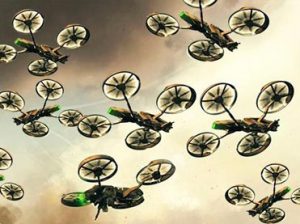 This was no mere variation on the practice of using Leer-3 drones for electronic warfare and to spot for Russian artillery. It marked the first-ever deployment of an entirely new Russian AI battle system complex, Omega. Nowak had only heard about the Russians firing entire drone swarms from inexpensive Grad rocket-artillery rounds once before in Syria while deployed with a US task force. But they had never done so in Ukraine, at least not that he knew about. Most observers chalked up Russia’s Syrian experimentations with battlefield robots and drone swarms to clumsy failures. Clearly something had changed.
This was no mere variation on the practice of using Leer-3 drones for electronic warfare and to spot for Russian artillery. It marked the first-ever deployment of an entirely new Russian AI battle system complex, Omega. Nowak had only heard about the Russians firing entire drone swarms from inexpensive Grad rocket-artillery rounds once before in Syria while deployed with a US task force. But they had never done so in Ukraine, at least not that he knew about. Most observers chalked up Russia’s Syrian experimentations with battlefield robots and drone swarms to clumsy failures. Clearly something had changed.
With his phone, Nowak recorded how the drones appeared to be coordinating their search activities as if they were a single hive intelligence. They divided the dense forest into cells they searched cooperatively. Within seconds, they climbed and dove from treetop height looking for anyone or anything hiding below.
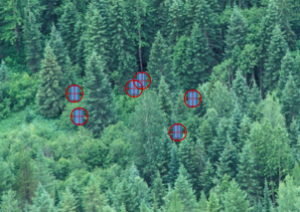 At that very instant, the drone’s computer vision algorithms detected Novak’s team. Each and every one of them. Within seconds, six of the aggressively maneuvering drones revealed themselves in a disjointed dive down from the treetops and zoomed in on the JWK fighters’ positions.
At that very instant, the drone’s computer vision algorithms detected Novak’s team. Each and every one of them. Within seconds, six of the aggressively maneuvering drones revealed themselves in a disjointed dive down from the treetops and zoomed in on the JWK fighters’ positions.
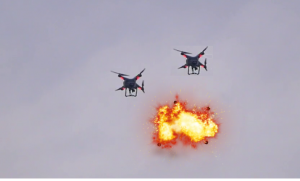 Nobody needed to be told what to do. The team raised their weapons and fired short bursts at the Russian drones. One shattered like a clay pigeon. But two more buzzed into view to take its place. Another drone went down to a shotgun-fired SkyNet round. Then the entire drone formation shifted its flight patterns, dodging and maneuvering even more erratically, making it nearly impossible to shoot the rest down. The machines learned from their own losses, Nowak realized. Would his superiors do the same for him?
Nobody needed to be told what to do. The team raised their weapons and fired short bursts at the Russian drones. One shattered like a clay pigeon. But two more buzzed into view to take its place. Another drone went down to a shotgun-fired SkyNet round. Then the entire drone formation shifted its flight patterns, dodging and maneuvering even more erratically, making it nearly impossible to shoot the rest down. The machines learned from their own losses, Nowak realized. Would his superiors do the same for him?
Nowak emptied his magazine with a series of quick bursts, but rather than reload he put his weapon aside and rolled out from under the log. Fully exposed and clutching the phone with shaking hands, he hastily removed one of his gloves with his teeth. Then he switched the device on. Network connected. He scrolled to the video of the drones. Send! Send! Send!
Eleven seconds later, Novak’s entire Polish JWK special forces team lay dead on the forest floor.

________________________________
Omega is not any one specific weapon, rather it is made up of a menagerie of Russian weapons, large and small. It’s as if you fused information warfare, SAMs, fires, drones, tactical autonomous bots… There’s everything from S-600 batteries to cheap Katyusha-style rocket artillery to Uran-9 and -13 tanks. But it is what controls the hardware that makes Omega truly unique: AI. At its core, it’s an artificial intelligence system fusing data from thousands of sensors, processed information, and found patterns that human eyes and minds cannot fathom. The system’s AI is not only developing a comprehensive real-time picture, it’s also developing probabilities and possible courses of enemy action. It can coordinate thousands of “shooters”, from surface-to-air missiles, to specialized rocket artillery deploying autonomous tactical drones like the ones that killed the JWK team, to UGVs like the latest Uran-13 autonomous tracked units.
The developers of the Omega system incorporated technologies such as software-defined radio, which uses universal receivers that could listen in to a broad array of frequencies. Thousands of these bands are monitored with machine learning algorithms to spot insurgent radio stations, spy on the locations of Ukrainian military and police, and even determine if a certain frequency is being used to remotely control explosives or other military equipment. When a threat is discovered, the system will dispatch drones to observe the triangulated location of the source. If the threat needs to be neutralized a variety of kinetic systems – from guided artillery shells to loitering munitions and autonomous drones – can be dispatched for the kill.
________________________________
If you enjoyed this excerpt, please:
Read the complete Omega short story, hosted by our colleagues at the Atlantic Council NATOSource blog,
Learn how the U.S. Joint Force and our partners are preparing to prevail in competition with our strategic adversaries and, when necessary, penetrate and dis-integrate their anti-access and area denial systems and exploit the resultant freedom of maneuver to achieve strategic objectives (win) and force a return to competition on favorable terms in The U.S. Army in Multi-Domain Operations 2028 Executive Summary, and
See one prescription for precluding the strategic surprise that is the fictional Omega in The Importance of Integrative Science/Technology Intelligence (InS/TINT) to the Prediction of Future Vistas of Emerging Threats, by Dr. James Giordano, CAPT (USN – Ret.) L. R. Bremseth, and Mr. Joseph DeFranco.
Reminder: You only have 1 week left to enter your submissions for the Mad Scientist Science Fiction Writing Contest 2019. Click here for more information about the contest and how to submit your short story(ies) for consideration by our 1 April 2019 deadline!
Mr. August Cole is a proclaimed Mad Scientist, author, and futurist focusing on national security issues. He is a non-resident senior fellow at the Art of the Future Project at the Atlantic Council. He also works on creative foresight at SparkCognition, an artificial intelligence company, and is a senior advisor at Avascent, a consulting firm. His novel with fellow proclaimed Mad Scientist P.W. Singer, entitled Ghost Fleet: A Novel of the Next World War, explores the future of great power conflict and disruptive technologies in wartime.
Mr. Amir Husain is the founder and CEO of SparkCognition, a company envisioned to be at the forefront of the “AI 3.0” revolution. He serves as advisor and board member to several major institutions, including IBM Watson, University of Texas Department of Computer Science, Makerarm, ClearCube Technology, uStudio and others; and his work has been published in leading tech journals, including Network World, IT Today, and Computer World. In 2015, Amir was named Austin’s Top Technology Entrepreneur of the Year.
Disclaimer: This publication is a work of fiction by Messrs. August Cole and Amir Husain, neither of whom have any affiliation with U.S. Army Training and Doctrine Command, the U.S. Army, or the U.S. Government. This piece is meant to be thought-provoking and entertaining, and does not reflect the current position of the U.S. Army.

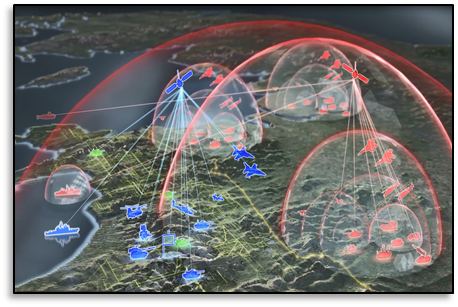

 In particular, we would like to recognize proclaimed Mad Scientist Dr. Alexander Kott by re-posting our review of his paper,
In particular, we would like to recognize proclaimed Mad Scientist Dr. Alexander Kott by re-posting our review of his paper,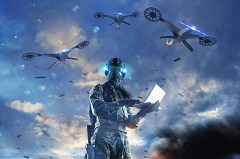 • The employment of small aerial drones for Intelligence, Surveillance, and Reconnaissance (ISR) will continue, making concealment difficult and eliminating distance from opposing forces as a means of counter-detection. This will require the development and use of decoy capabilities (also intelligent robotic devices). This counter-reconnaissance fight will feature prominently on future battlefields between autonomous sensors and countermeasures – “a robot-on-robot affair.”
• The employment of small aerial drones for Intelligence, Surveillance, and Reconnaissance (ISR) will continue, making concealment difficult and eliminating distance from opposing forces as a means of counter-detection. This will require the development and use of decoy capabilities (also intelligent robotic devices). This counter-reconnaissance fight will feature prominently on future battlefields between autonomous sensors and countermeasures – “a robot-on-robot affair.” • The continued proliferation of intelligent munitions, operating at greater distances, collaborating in teams to seek out and destroy designated targets, and able to defeat armored and other hardened targets, as well as defiladed and entrenched targets.
• The continued proliferation of intelligent munitions, operating at greater distances, collaborating in teams to seek out and destroy designated targets, and able to defeat armored and other hardened targets, as well as defiladed and entrenched targets.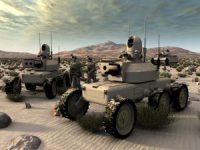 • Increasing reliance on unmanned systems, “with humans becoming a minority within the overall force, being further dispersed across the battlefield.”
• Increasing reliance on unmanned systems, “with humans becoming a minority within the overall force, being further dispersed across the battlefield.”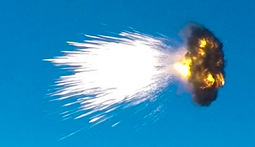 • Intelligent munitions will be neutralized “primarily by missiles and only secondarily by armor and entrenchments. Specialized autonomous protection vehicles will be required that will use their extensive load of antimissiles to defeat the incoming intelligent munitions.”
• Intelligent munitions will be neutralized “primarily by missiles and only secondarily by armor and entrenchments. Specialized autonomous protection vehicles will be required that will use their extensive load of antimissiles to defeat the incoming intelligent munitions.”
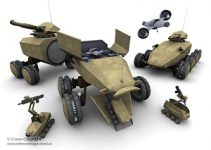
 • “To gain protection from intelligent munitions, extended subterranean tunnels and facilities will become important. This in turn will necessitate the tunnel-digging robotic machines, suitably equipped for battlefield mobility.”
• “To gain protection from intelligent munitions, extended subterranean tunnels and facilities will become important. This in turn will necessitate the tunnel-digging robotic machines, suitably equipped for battlefield mobility.”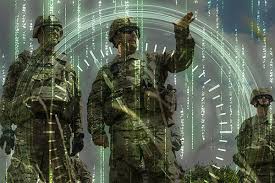 • All of these autonomous, yet simultaneously integrated and networked battlefield systems will be vulnerable to Cyber-Electromagnetic Activities (CEMA). Consequently, the battle within the Cyber domain will “be fought largely by various autonomous cyber agents that will attack, defend, and manage the overall network of exceptional complexity and dynamics.”
• All of these autonomous, yet simultaneously integrated and networked battlefield systems will be vulnerable to Cyber-Electromagnetic Activities (CEMA). Consequently, the battle within the Cyber domain will “be fought largely by various autonomous cyber agents that will attack, defend, and manage the overall network of exceptional complexity and dynamics.” • The “high volume and velocity of information produced and demanded by the robot-intensive force” will require an increasingly autonomous Command and Control (C2) system, with humans increasingly being on, rather than in, the loop.
• The “high volume and velocity of information produced and demanded by the robot-intensive force” will require an increasingly autonomous Command and Control (C2) system, with humans increasingly being on, rather than in, the loop.



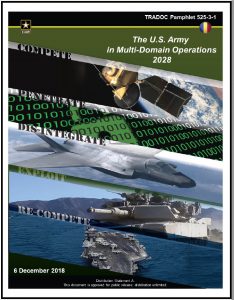 The
The
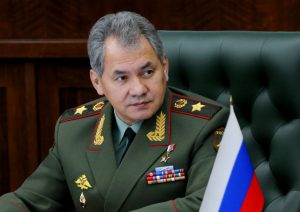
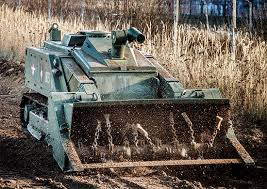
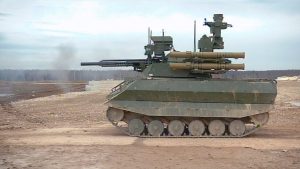

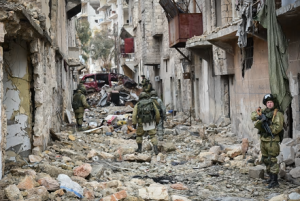
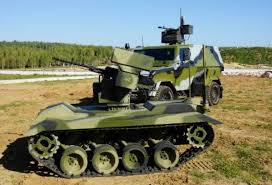

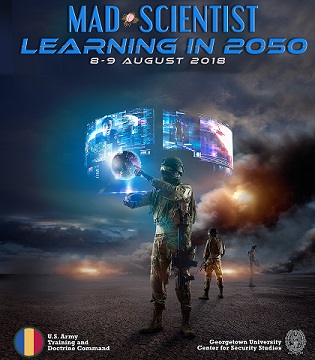 [Editor’s Note: At the Mad Scientist Learning in 2050 Conference with Georgetown University’s Center for Security Studies in Washington, DC, Leading scientists, innovators, and scholars gathered to discuss how humans will receive, process, and integrate information in the future. The convergence of technology, the speed of change, the generational differences of new Recruits, and the uncertainty of the Future Operational Environment will dramatically alter the way Soldiers and Leaders learn in 2050. One clear signal generated from this conference is that learning in the future will be personalized, continuous, and accelerated.]
[Editor’s Note: At the Mad Scientist Learning in 2050 Conference with Georgetown University’s Center for Security Studies in Washington, DC, Leading scientists, innovators, and scholars gathered to discuss how humans will receive, process, and integrate information in the future. The convergence of technology, the speed of change, the generational differences of new Recruits, and the uncertainty of the Future Operational Environment will dramatically alter the way Soldiers and Leaders learn in 2050. One clear signal generated from this conference is that learning in the future will be personalized, continuous, and accelerated.] The world is becoming increasingly personalized, and individual choice and preference drives much of daily life, from commerce, to transportation, to entertainment. For example, your Amazon account today can keep your payment information on file (one click away), suggest new products based on your purchase history, and allow you to shop from anywhere and ship to any place, all while tracking your purchase every step of the way, including providing photographic proof of delivery. Online retailers, personal transportation services, and streaming content providers track and maintain an unprecedented amount of specific individual information to deliver a detailed and personalized experience for the consumer.
The world is becoming increasingly personalized, and individual choice and preference drives much of daily life, from commerce, to transportation, to entertainment. For example, your Amazon account today can keep your payment information on file (one click away), suggest new products based on your purchase history, and allow you to shop from anywhere and ship to any place, all while tracking your purchase every step of the way, including providing photographic proof of delivery. Online retailers, personal transportation services, and streaming content providers track and maintain an unprecedented amount of specific individual information to deliver a detailed and personalized experience for the consumer. An important facet of personalized learning is personal attention to the learner. Tutors have been used in education for 60,000 years.
An important facet of personalized learning is personal attention to the learner. Tutors have been used in education for 60,000 years.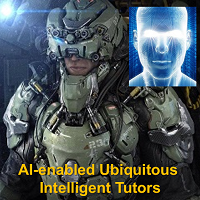 Research indicates that students who have access to tutors as opposed to exclusive classroom instruction were more effective learners as seen in the chart below. In other words, the average tutored student performed better than 98 percent of the students in the traditional classroom.
Research indicates that students who have access to tutors as opposed to exclusive classroom instruction were more effective learners as seen in the chart below. In other words, the average tutored student performed better than 98 percent of the students in the traditional classroom.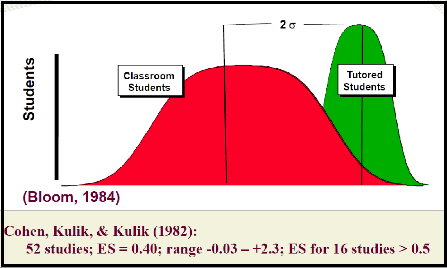
 simulations, and video; and universal interfaces reduces or eliminates the necessity for physical co-location. This allows Soldiers to attend courses hosted virtually anywhere, participate in combined arms and Joint exercises globally, and experience a variety of austere and otherwise inaccessible environments through virtual and augmented reality.
simulations, and video; and universal interfaces reduces or eliminates the necessity for physical co-location. This allows Soldiers to attend courses hosted virtually anywhere, participate in combined arms and Joint exercises globally, and experience a variety of austere and otherwise inaccessible environments through virtual and augmented reality.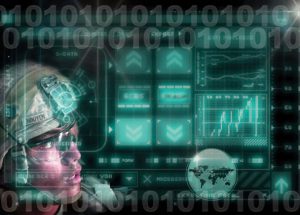 Learners must be given the chance to fail, and failure must be built in to the continuous learning process so that the learner not only arrives at the solution organically, but practices critical thinking and evaluation skills.
Learners must be given the chance to fail, and failure must be built in to the continuous learning process so that the learner not only arrives at the solution organically, but practices critical thinking and evaluation skills. The concept of accelerated learning, or using a compressed timeline and various approaches, methodologies, or technological means to maximize learning, opens up several questions: what kinds of technologies accelerate learning, and how does technology accelerate learning? Technologies useful for accelerated learning include the immersive reality spectrum – virtual reality/augmented reality (mixed reality) and haptic feedback – as well as wearables, neural stimulation, and brain mapping. These technologies and devices enable the individualization and personalization of learning. Individualization allows the learner to identify their strengths and weaknesses in learning, retaining, and applying information and provides a program structured to capitalize on his/her naturally favored learning style to maximize the amount and depth of information presented in the most time and cost-effective manner.
The concept of accelerated learning, or using a compressed timeline and various approaches, methodologies, or technological means to maximize learning, opens up several questions: what kinds of technologies accelerate learning, and how does technology accelerate learning? Technologies useful for accelerated learning include the immersive reality spectrum – virtual reality/augmented reality (mixed reality) and haptic feedback – as well as wearables, neural stimulation, and brain mapping. These technologies and devices enable the individualization and personalization of learning. Individualization allows the learner to identify their strengths and weaknesses in learning, retaining, and applying information and provides a program structured to capitalize on his/her naturally favored learning style to maximize the amount and depth of information presented in the most time and cost-effective manner. digital learning platform, providing real-time, individual feedback and suggesting areas for improvement or those in need of increased attention. Intelligent tutors and other technologies utilized in the accelerated learning process, such as augmented reality, can be readily adapted to a variety of situations conforming to the needs of a specific unit or mission.
digital learning platform, providing real-time, individual feedback and suggesting areas for improvement or those in need of increased attention. Intelligent tutors and other technologies utilized in the accelerated learning process, such as augmented reality, can be readily adapted to a variety of situations conforming to the needs of a specific unit or mission.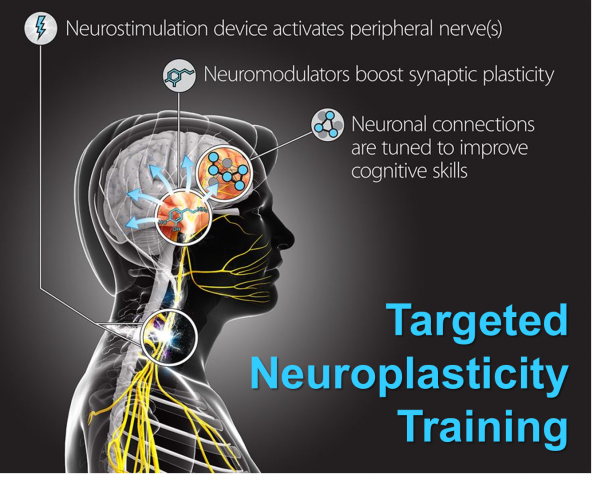 Accelerated learning does not guarantee positive outcomes. There is a high initial startup cost to producing mixed, augmented, and virtual reality training programs, and these programs require massive amounts of data and inputs for the most realistic product.
Accelerated learning does not guarantee positive outcomes. There is a high initial startup cost to producing mixed, augmented, and virtual reality training programs, and these programs require massive amounts of data and inputs for the most realistic product. An increased emphasis on continuous and accelerated learning could present the Army with an opportunity to have Soldiers that are lifelong learners capable of quickly picking up emerging required skills and knowledge. However, this focus would need to account for peak learner interest and long-term viability.
An increased emphasis on continuous and accelerated learning could present the Army with an opportunity to have Soldiers that are lifelong learners capable of quickly picking up emerging required skills and knowledge. However, this focus would need to account for peak learner interest and long-term viability.